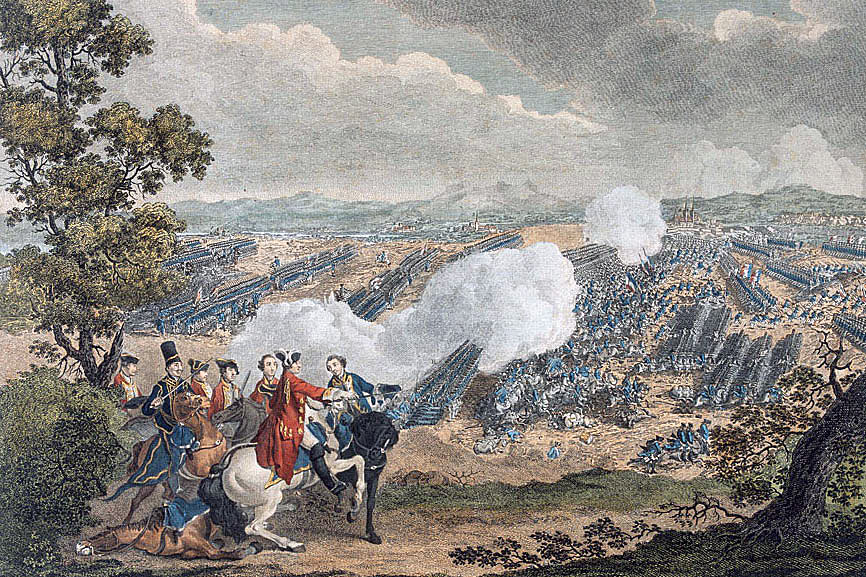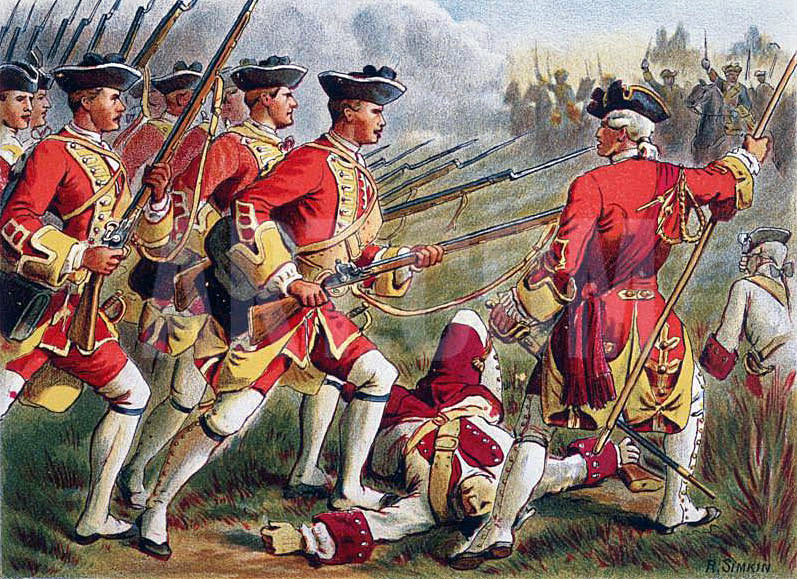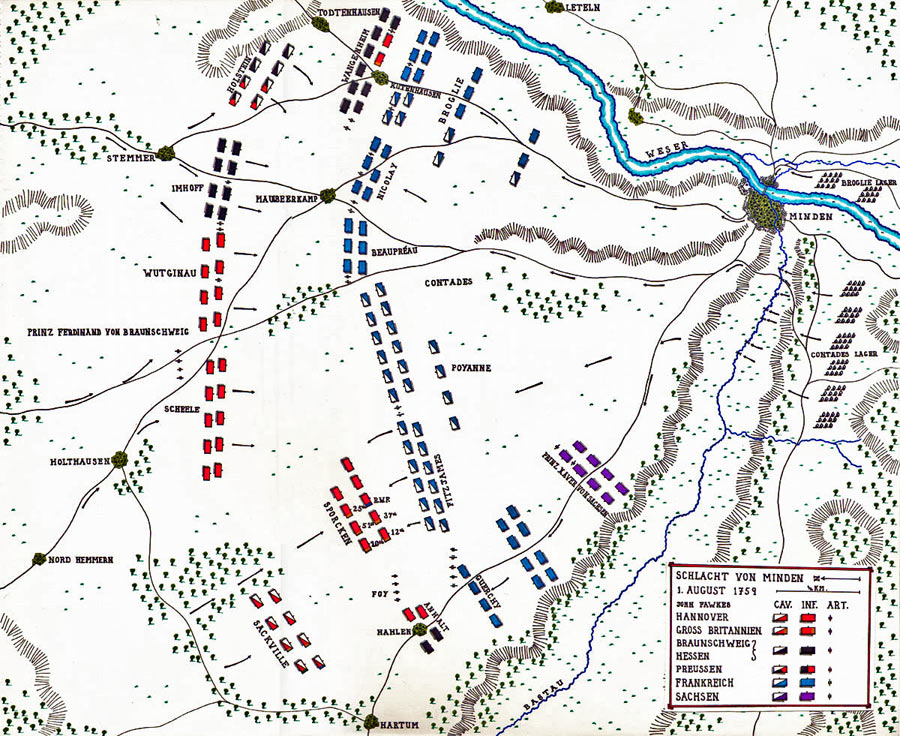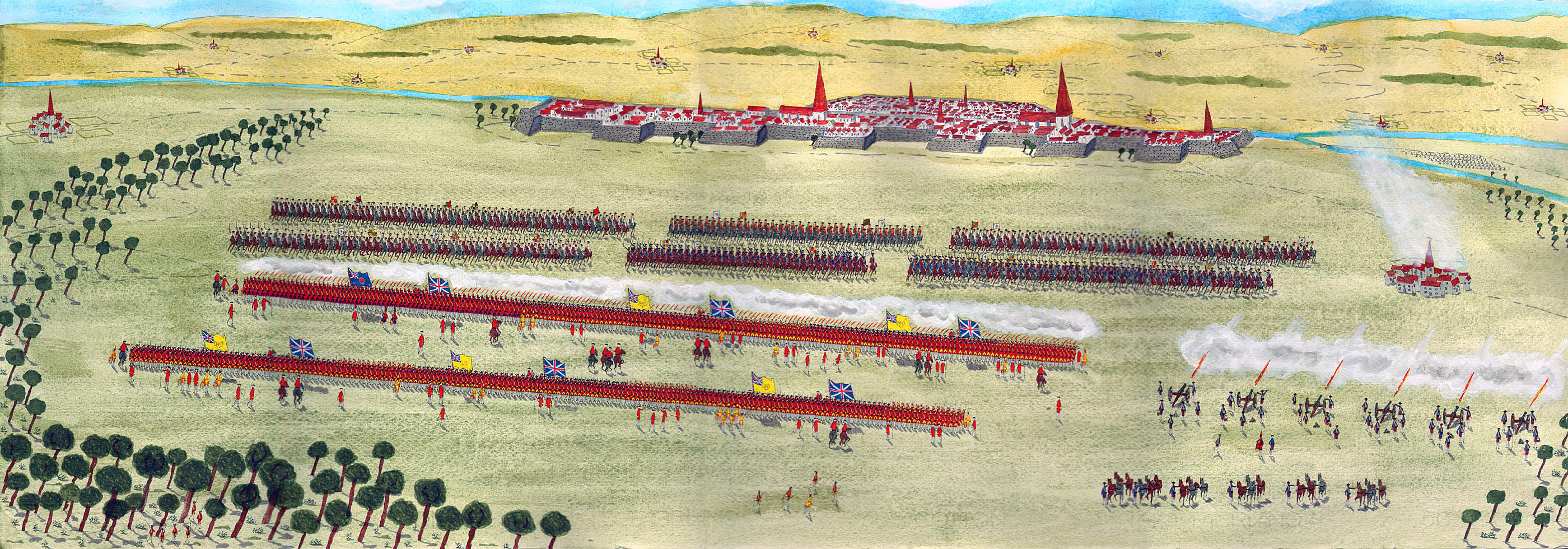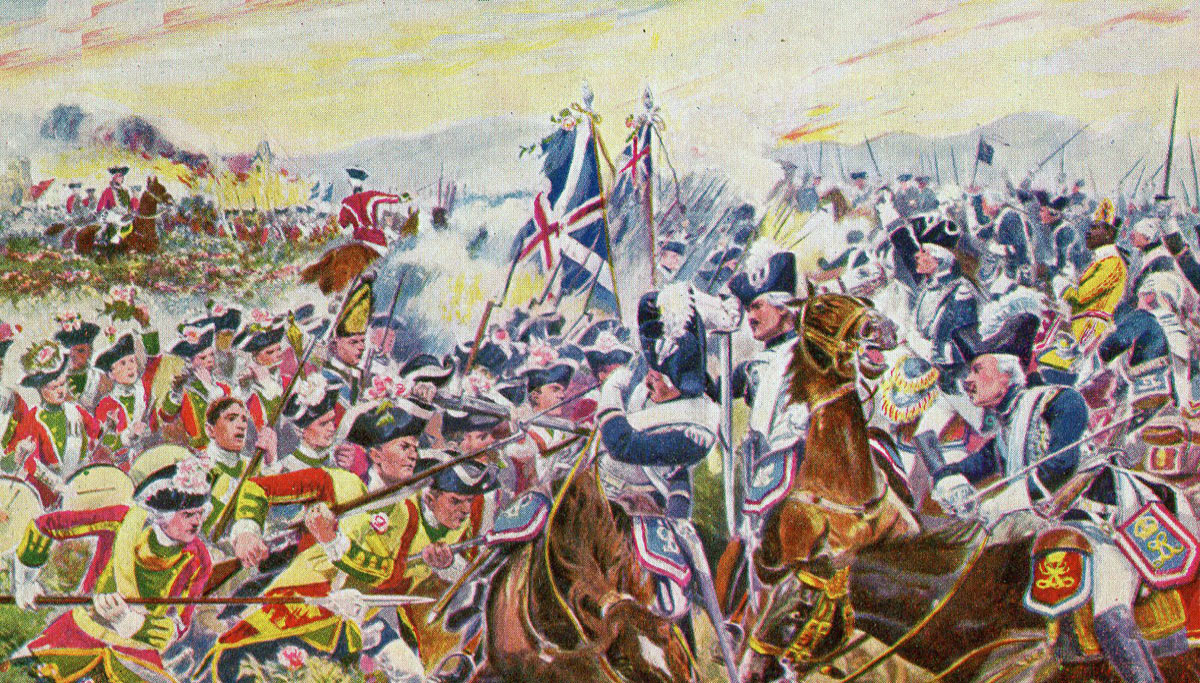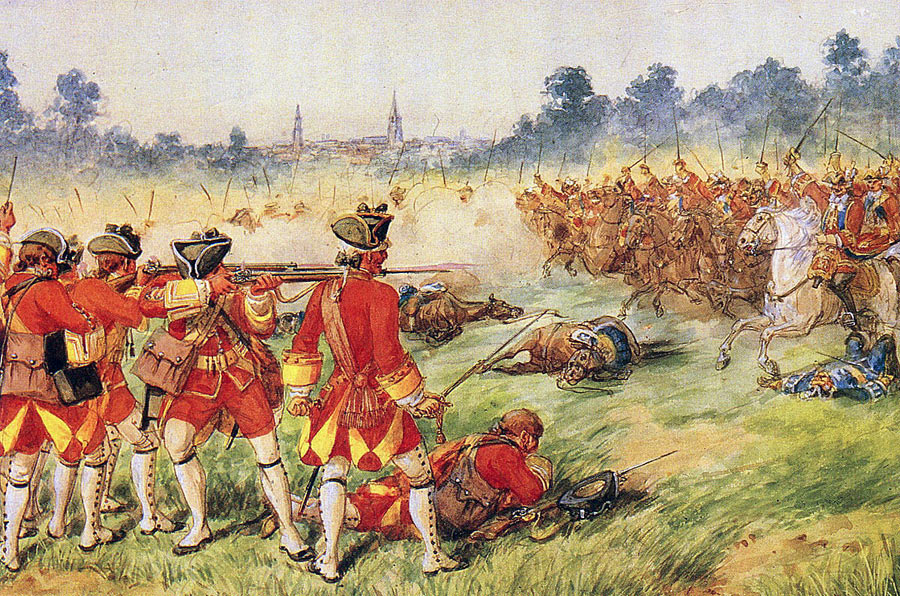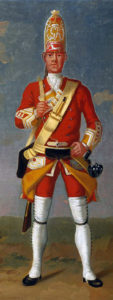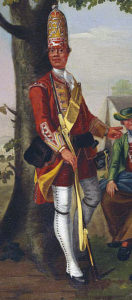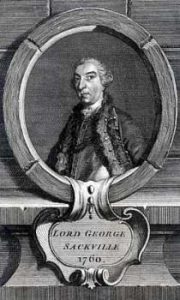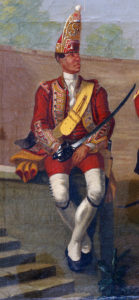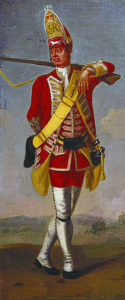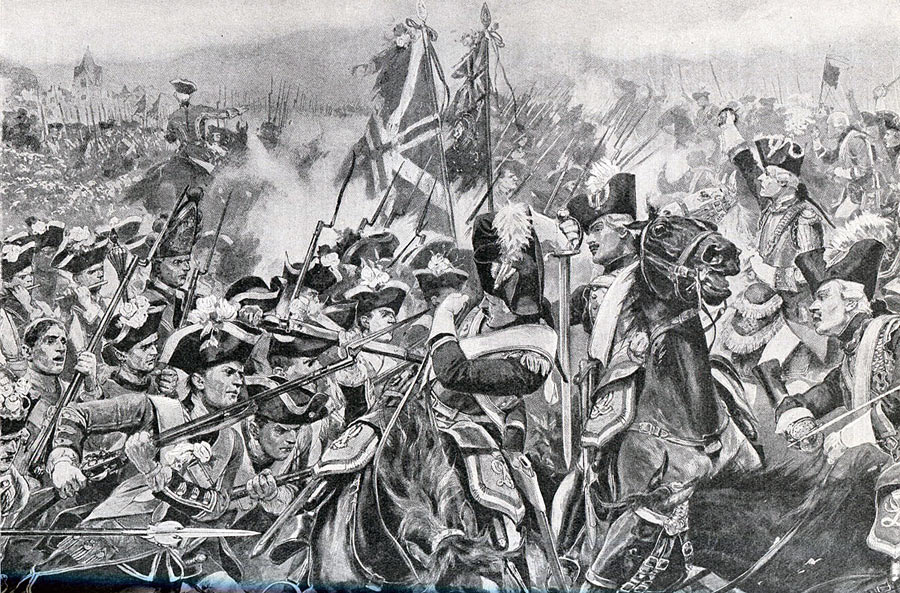Minden: an iconic victory on 1st August 1759 for the British “Minden” Regiments who advanced to battle with white roses in their hats, plucked from the hedgerows and repelled the attacks of French cavalry
The previous battle of the Seven Years War is the Battle of Burkersdorf
The next battle of the Seven Years War is the Battle of Emsdorf
Battle: Minden
War: Seven Years War
Date of the Battle of Minden: 1st August 1759
Place of the Battle of Minden: Minden in North Germany
Combatants at the Battle of Minden: British, Hanoverians, Hessians and Prussians against French and Saxons
Generals at the Battle of Minden: Prince Ferdinand of Brunswick against Marshal the Marquis de Contades
Size of the armies at the Battle of Minden:
41,000 British and Germans with 170 guns against 51,000 French and Saxons with 162 guns.
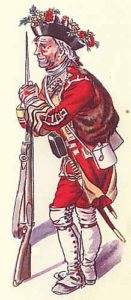
Soldier of the 20th Foot with roses in his hat at the Battle of Minden 1st August 1759 in the Seven Years War
Uniforms, arms and equipment at the Battle of Minden:
All regular European soldiers of this time fought in a knee length uniform coat, turned back at the skirt, cuffs and lapels to reveal a distinctive regimental lining colour. Headgear was a black tricorne hat with a lace brim, except for grenadiers who wore a tall mitre cap. In some armies the grenadier mitre was giving way to a bearskin cap. The uniform was white for the majority of French regiments, blue for the Prussians and German armies that followed the Prussian tradition, like Hesse-Darmstadt, and red for the British and Hanoverians. There were exceptions within every army. The French Royal Household troops wore a variety of coats. The foreign mercenary regiments in the French service wore red or blue. The Hanoverian and Hessen horse wore white. The British Royal Artillery and Royal Horse Guards wore blue coats.
The standard infantry weapon was the musket and bayonet. The musket fired a ball propelled by black powder loaded, one shot at a time, through the muzzle. A skilled infantryman might fire 3 to 4 shots a minute. The black powder quickly fouled the musket making loading and firing increasingly difficult. Misfires were frequent particularly in wet weather. The ammunition scale for a British soldier was 24 rounds. Arrangements for replenishing the supply during a battle were haphazard.
The artillery was armed with muzzle loading cannon. The ease with which the guns could be moved about the battlefield varied according to the army. The British Royal Artillery was still hampered by a lack of full-time teams to draw the guns, relying on civilians engaged for the war. The British batteries at Minden were armed with light guns, which could if necessary be moved by hand.
Winner: Prince Ferdinand’s army.
British Regiments at the Battle of Minden:
12th, 20th, 23rd, 25th, 37th and 51st Regiments of Foot in Waldegrave’s and Kingsley’s brigades. These regiments have Minden as a battle honour.
Sackville’s command contained The Royal Horse Guards, 1st and 3rd Dragoon Guards, the Scots Greys and the 10th Dragoons. The Marquis of Granby was second in command to Lord George Sackville.
The Royal Artillery companies of Captains Phillips, MacBean, Drummond, Williams and Foy.
12th Foot: later the Suffolk Regiment and now the Royal Anglian Regiment*
20th Foot: later the Lancashire Fusiliers and now the Royal Regiment of Fusiliers*
23rd Foot, the Royal Welch Fusiliers, now the Royal Welsh*
25th Foot: later the King’s Own Scottish Borderers and now the Royal Regiment of Scotland*
37th Foot: later the Hampshire Regiment and now the Princess of Wales’s Royal Regiment*
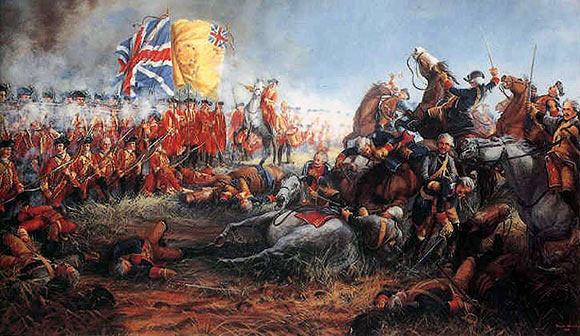
37th Foot, the centre regiment of the first line of British foot, repelling the attack of the French cavalry at the Battle of Minden
Copies of this picture can be purchased from the Regimental Museum of the Royal Hampshire Regiment in Winchester; proceeds go to regimental funds.
51st Foot: later the King’s Own Yorkshire Light Infantry and now the Rifles.
Royal Horse Guards: now the Blues and Royals*
1st Dragoon Guards: now the Queen’s Dragoon Guards
3rd Dragoon Guards: later the 3rd Carabineers and now the Royal Scots Dragoon Guards
The Royal Scots Greys: now the Royal Scots Dragoon Guards 10th Dragoons: later the 10th Light Dragoons, then the 10th Hussars, then the Royal Hussars and now the King’s Royal Hussars.
*These regiments were awarded Minden as a battle honour.
Account of the Battle of Minden:
In 1759 two French armies threatened Western Germany. By the end of July the Marquis de Contades with the Rhine Army had successfully fought his way to the Weser, capturing a number of important towns, and lay at Minden. Hanover was invaded and the city of Hanover itself threatened by the French. The Duc de Broglie was encamped on the east bank of the Weser.
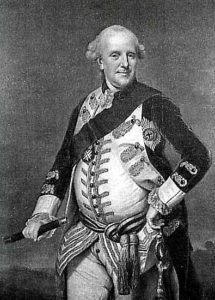
Prince Ferdinand, Duke of Brunswick, allied commander at the Battle of Minden 1st August 1759 in the Seven Years War
Prince Ferdinand with his army lay to the north of Minden. While Ferdinand’s primary allegiance was to his King, Frederick of Prussia, he commanded King George II’s forces and was bound to serve his interests, in particular to preserve the Electorate of Hanover from French invasion.
Contades had adopted an impregnable position, the French camp lying to the south west of the town of Minden behind the boggy Bastau River. A French garrison held Minden and Broglie was across the Weser. Detached French forces were hurrying to join the main army, Ferdinand felt it necessary to bring matters to a conclusion without delay.
General Wangenheim with his corps of German troops advanced to Todtenhausen, a few miles north of Minden on the west bank of the Weser, and entrenched. Ferdinand’s main army lay to the west. Ferdinand appeared to be concerned with the manoeuvres he was conducting against Contades’ left flank and rear. It is said that Ferdinand wished to give Contades the impression that he had left Wangenheim to fend for himself. When Contades moved against Wangenheim, Ferdinand would have the opportunity to attack the French as they crossed the Bastau.
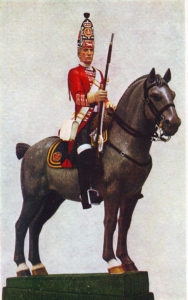
Royal Scots Greys 1759: Battle of Minden 1st August 1759 in the Seven Years War: statuette by Pilkington Jackson
Contades was also under pressure to produce a resounding success. His subordinates were restless and Marshal Belleisle, the French Minister of War was pressing for a move against the enemy.
The French camp, while providing an excellent defensive position, was not well placed for launching an aggressive move. There were but two bridges immediately to the west of Minden, insufficient for the passage of a large force of troops.
Contades built eight bridges of boats across the Bastau. It was impossible to conceal such activity from Ferdinand and it was apparent that the French intended to fall in with his plans and attack Wangenheim. Ferdinand did not know when the attack would be carried out. He ordered a careful watch and directed that all French deserters be sent to him immediately on capture.
On 31st July 1759 Contades ordered that the attack be made the next day, with the French Army crossing the bridges of boats during the night. Broglie was ordered to cross the Weser and march through Minden to the North. Artillery and 8 battalions of grenadiers would be provided to him from the main army as it crossed the Bastau. Broglie was to assault Wangenheim’s corps in its positions before Todtenhausen at dawn and drive him back. The French army would then fall on the rest of Prince Ferdinand’s army in its positions to the West.
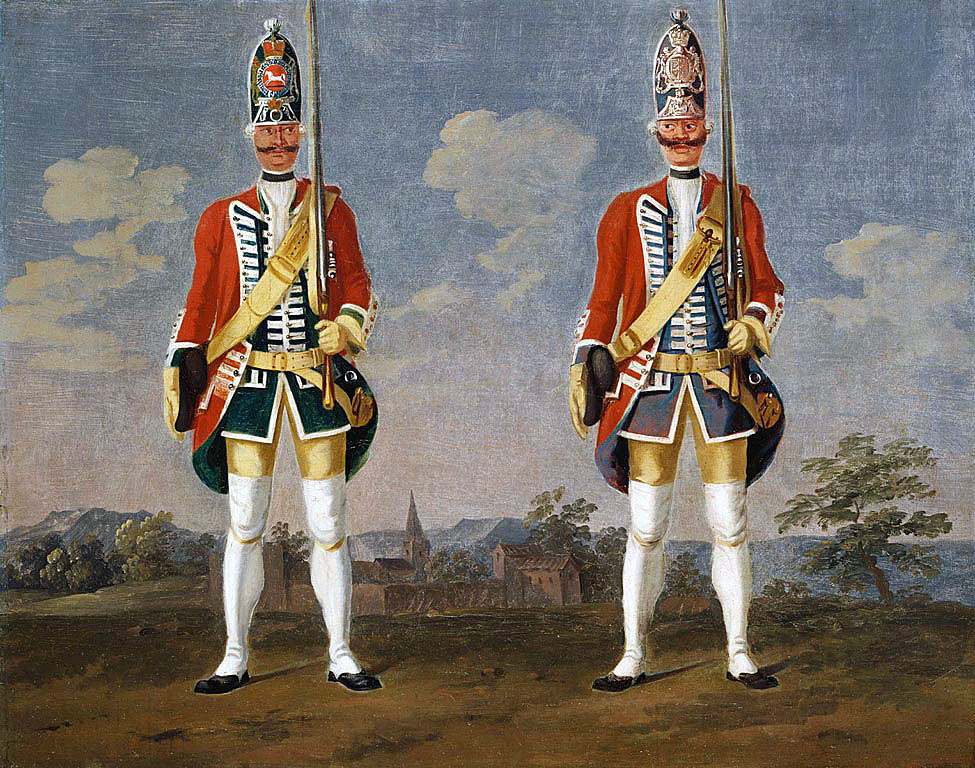
Hanoverian Regiments ‘Borch’ and ‘Brunck’: Battle of Minden 1st August 1759 in the Seven Years War: picture by David Morier
The next column was of Hanoverian artillery, then a force of British and Hanoverian foot under General Sporcken, then Generals Wutginau and Imhoff and on the left of the line General Holstein-Gottorp’s cavalry. There were two further columns of artillery. In front of the army was a screen of piquets commanded by Lieutenant General Prince Karl of Anhalt-Bernberg.
Two French deserters were taken by Anhalt’s piquets and revealed that the French Army was crossing the Bastau and moving forward to the attack. It is said that Anhalt delayed for two hours before passing this information to his commander, Prince Ferdinand. As soon as the news was relayed the army’s 8 columns were ordered forward.
All responded, except Sackville’s cavalry, who were not ready. This created an immediate problem as it was Sackville’s responsibility to capture the village of Hahlen on the critical right flank of the army. The task had to be given to Anhalt’s piquets. The French had been delayed in crossing the Bastau and were coming up slowly, enabling Anhalt to take the village in spite of fierce fighting. Anhalt’s piquets were assisted by Foy’s and MacBean’s batteries of British artillery which came up and bombarded the French infantry, the artillery being commanded by Captain Phillips.
While Hahlen was being taken by Anhalt, Ferdinand intended that his line should pause and resume the advance with its flank secured. In particular Ferdinand needed Sackville’s British and Hanoverian cavalry to come up into the line.
Sporcken’s column, intended to be second from the right after Sackville’s, comprised two brigades of British infantry. The leading brigade, commanded by Major General Waldegrave, consisted of the British 23rd Foot (the Royal Welch Fusiliers), the 37th Foot and the 12th Foot.
The second brigade, commanded by Major General Kingsley, consisted of the 25th Foot, the 51st Foot, a newly raised regiment, and the 20th Foot, Major General James Wolfe’s old regiment. On the previous day, as these regiments had marched up from Prince Ferdinand’s camp near Hille, they had picked wild roses from the hedges and decorated their hats and uniforms.
There now occurred one of the incidents beloved of British military history. It is said that an order was sent that the infantry were to “advance on the beat of drum” and that this was misinterpreted as an order to “advance to the beat of drum”. Waldegrave’s brigade set off towards the French line, followed by Kingsley’s.
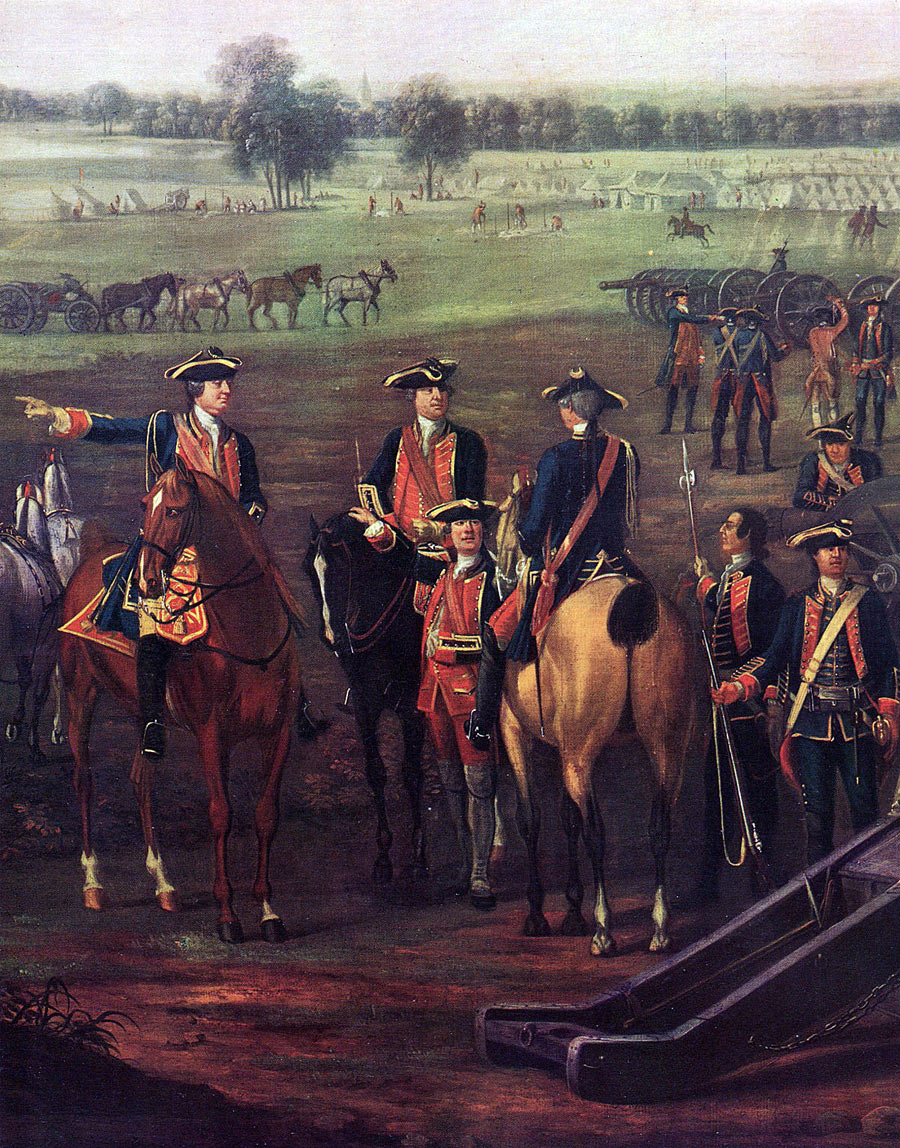
Officers of the Royal Artillery: Battle of Minden 1st August 1759 in the Seven Years War: picture by David Morier
At some stage during the subsequent fighting the two brigades were reinforced on their left flank by battalions from the Hanoverian Foot Guards and Hardenburg’s Hanoverian Regiment.
Contades’ plan had been carefully prepared by his staff officers with troops allocated to particular bridges and an order of battle that put the cavalry in the centre of the line, due to the marshy ground to the north of the Bastau River. Mid-eighteenth century armies did not have the structures or discipline to conduct a night-time move across improvised bridging on such a large scale. This was particularly so of the Bourbon French Army with its officer corps drawn from an arrogant and unprofessional nobility. In addition, the weather broke during the night with high winds and rain. Crossing the Bastau took longer than planned and the troops were debouching onto the Minden plain late and in confusion. It will not have been lost on the soldiers that in the event of the battle going badly the retreat would be infinitely more difficult.
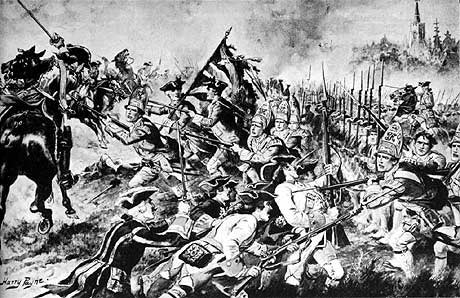
British and Hanoverian Foot attack the French Cavalry at the Battle of Minden on 1st August 1759 in the Seven Years War
Broglie began his assault on Wangenheim’s corps, but with little drive and the attack dissolved into an artillery duel between the two sides.
On the right of Ferdinand’s line, Sporcken’s British and Hanoverian column marched past the struggle in the village of Hahlen and headed for the mass of French cavalry in the centre of Contades’ line.
Waldegrave’s brigade outstripped Kingsley’s and halted by a copse. After a pause the brigade resumed its advance angling to its left at the flank of the French Horse. Kingsley’s men pressed on in support. The two brigades emerged from the copse and now in full sight of the French army, they attracted the fire of the French guns along the line, from right and left.
The French cavalry commander, Lieutenant General Fitzjames, launched his first attack on the British and Hanoverian foot, 11 squadrons of the regiments Royal Cravates and the Mestre de Camp under the Marquis de Castries. The charge was received with fire and dispersed. The second French charge was delivered by 22 squadrons of the regiments Royal Étranger, Bourgogne and Brigade du Roi. Again the charge was dispersed.
Lieutenant General Comte Guerchy, falling back from the fighting in Hahlen, directed 8 of his infantry battalions in an attack on the right flank of Sporcken’s column. Prince Ferdinand was near at hand supervising the fighting and he ordered forward General Scheele with 5 Hanoverian battalions and a substantial force of Hanoverian guns on Sporcken’s right.
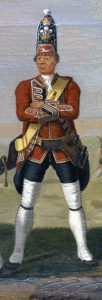
Grenadier of 23rd Royal Welch Fusiliers: Battle of Minden on 1st August 1759 in the Seven Years War: David Morier
At the same time the third French cavalry attack was delivered by the Gendarmerie de France and the Carabineers led by Lieutenant General de Poyanne. This charge lapped around the right flank of Sporcken’s column. The British and Hanoverian foot held firm considerably assisted by the fire from the column to its left, Wutginau’s Hanoverian and Hessian Foot.
Guerchy’s infantry assault was driven back, as was Poyanne’s cavalry charge. The remainder of Ferdinand’s line was coming up with Sporcken’s British and Hanoverian regiments and the French were pressed back, particularly by the heavy and well delivered fire of the British and Hanoverian artillery.
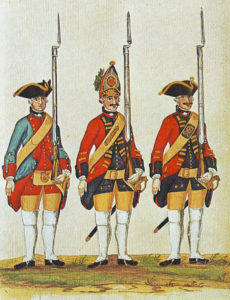
Hanoverian Artillery and Grenadier and ‘hat company man’ of Foot Guards: Battle of Minden 1st August 1759 in the Seven Years War: picture by Karsten
During these critical phases of the battle Prince Ferdinand sent four separate orders to Sackville to attack with his powerful cavalry force. Every time Sackville refused to obey the order. Sackville’s deputy commander, the Earl of Granby attempted to lead the force forward but was ordered to halt by Sackville. It is said that if the British and Hanoverian cavalry had charged the overthrow of the French army would have been complete.
As it was the final stage of the battle was being reached. Contades ordered General Beaupréau with 8 battalions positioned on the right of the main French line to attack Prince Ferdinand’s flank. Beaupréau’s battalions were counterattacked by 4 Hanoverian battalions, that drove them back through the village of Maulbeerkamp, before being charged in the rear by 19 Prussian and Hanoverian squadrons. Covered by Beaupréau’s second line the French began to fall back.
On Contades’ left a force of Saxon foot came forward, but after a fierce battle with Sporcken’s column and heavy artillery fire, they fell back with the disordered remnants of the French army to the Bastau bridges.
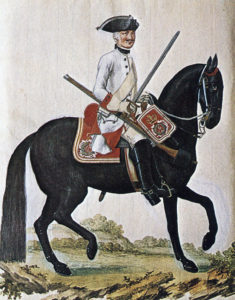
Hanoverian Regiment of Horse von Hardenburg: Battle of Minden 1st August 1759 in the Seven Years War: picture by Karsten
The British light guns of Foy and MacBean moved forward and bombarded the French troops as they retreated across the bridges of boats causing further significant casualties.
Casualties
Prince Frederick’s army suffered 2,600 casualties of which half were from the British infantry and artillery. The British right flank regiments, the 12th and 20th, suffered particularly heavily.
Royal Artillery: 3 officers and 11 men killed and wounded
12th Foot: 17 officers and 272 men killed and wounded
20th Foot: 17 officers and 304 men killed and wounded
23rd Foot, Royal Welch Fusiliers: 10 officers and 196 men killed and wounded
25th Foot: 7 officers and 138 men killed and wounded
37th Foot: 15 officers and 231 men killed and wounded
51st Foot: 10 officers and 98 men killed and wounded
Contades and Broglie in correspondence stated the French casualties to be between 10,000 and 11,000. The French army lost much of its baggage, 17 standards and colours and 43 guns.
Follow-up to the Battle of Minden:
During Contades’ advance the Hereditary Prince, operating in the French rear, captured Gohfeld on their lines of communications. After the battle Contades crossed the Weser and withdrew to Cassel, abandoning the towns the French had captured during the earlier part of the year.
- Minden Day – Minden is a victory replete with symbolism and controversy for the British Army. The six infantry regiments and their successors celebrate Minden Day with parades and dinners, decorating their hats and accoutrements with wild roses to commemorate the picking and wearing of the roses as they advanced through the countryside on 31st July and 1st August 1759.
- Marshal Contades is reputed to have said bitterly after the battle: “I never thought to see a single line of infantry break through three lines of cavalry ranked in order of battle and tumble them to ruin.”
- Major General Waldegrave was promoted to Lieutenant General.
- Against this success is set the dark failure of the cavalry under Sackville. Sackville was dismissed from the army by King George II. He insisted on being tried by general court martial and his demand was conceded. Sackville was tried at the Horse Guards for disobeying Prince Ferdinand’s orders. He was convicted and the sentence was that he should never serve His Majesty in any capacity thereafter. Unfortunately the sentence was not maintained and in the next reign Sackville, under the name of Lord Germaine, became Secretary for War and directed the operations of the British Army during the American War of Independence.
- The attention paid to the British Infantry after Minden has overshadowed the contribution of the other forces under Prince Ferdinand. The handling of the Prince’s artillery under the Count of Lippe-Buckeburg was masterful. The chronicler of the campaign, Westphalen, picks out the conduct of the British Royal Artillery for particular praise. Foy and MacBean took their guns to the edge of the field and harassed the retreating French army, performing the function Sackville so resolutely refused to accept for his cavalry.
- It is said that Prince Ferdinand wrote to Captain MacBean saying; “It is to you and your brigade that I am indebted for having silenced the fire of a battery of the enemy, which extremely galled the troops”. The Prince directed his paymaster to distribute the sums of 1,000 crowns to Captain Phillips and 500 each to Captains MacBean, Drummond, Williams and Foy for distribution amongst their men.
- Captain Phillips, as Major General Phillips, in the American War of Independence in 1777 commanded the Royal Artillery under Major General Burgoyne during the campaign that led to the surrender at Saratoga.
- The performance of the Prussian dragoons on the left flank of Prince Ferdinand’s line was quite in keeping with the highest traditions of the Prussian service, as was that of the Hanoverian troops and in particular the Hanoverian Foot Guards and the battalion of Hardenburg’s Regiment that advanced with Waldegrave and Kingsley’s brigades.
- Every year on 1st August 6 red roses are delivered anonymously to the British Consulate in Chicago, with a card commemorating the Battle of Minden and giving the list of 6 British infantry regiments that fought at the battle.
References for the Battle of Minden:
- His Britannic Majesty’s Army in Germany during the Seven Year War by Savory
- Fortescue’s History of the British Army
The previous battle of the Seven Years War is the Battle of Burkersdorf
The next battle of the Seven Years War is the Battle of Emsdorf
